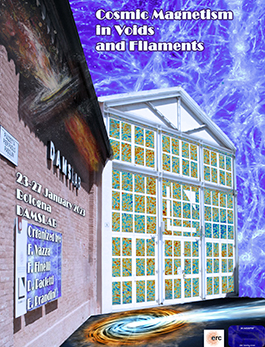Conveners
Friday
- Daniela Paoletti (Istituto Nazionale di Astrofisica (INAF))
I will discuss how parity violation affects dynamics of magnetic fields in various systems.
Subsonic turbulence is a difficult problem for many numerical methods to handle. We use our new implementation of Meshless Finite Mass (MFM) in OpenGadget3 to calculate decaying, subsonic turbulence. Comparing the performance to other methods, including Smoothed Particle Hydrodynamics (SPH) in OpenGadget3, and a moving and a stationary mesh using the publicly available AREPO code, we show that...
We study the effect of a tangled sub-fG level intergalactic magnetic field (IGMF) on the electrostatic instability of a blazar-induced pair beam. Sufficiently strong IGMF may significantly deflect the TeV pair beams, which would reduce the flux of secondary cascade emission below the observational limits. A similar flux reduction may result from the electrostatic beam–plasma instability,...
Gravitational waves from primordial first order phase transitions
offer interesting possibilities to probe physical processes at high
energy scales, in the early universe. Several GW sources can act
during, and in the aftermath, of the phase transition. Among these,
this talk concentrates on the turbulent motion possibly generated in
the surrounding plasma, and possibly accompanied by a...
Magnetic fields generated during inflation or during phase-transitions result in rather different gravitational wave signatures. In my talk, I will present results from recent high resolution numerical simulations. There are significant differences in the gravitational wave spectra from earlier analytic calculations. A particularly important feature is a sharp drop in the spectral power at...
The impact of viscosity on the Intracluster Medium (ICM) is still under debate and it can be essential in mixing and turbulence processes and, therefore, the interaction of galaxies within galaxy clusters and the evolution of galaxies. For this reason, a deep study on the effect that viscosity has in the evolution of Galaxy Clusters from a numerical simulation point of view can give us a hint...
Post-reionization neutral hydrogen (HI) intensity mapping (IM) offers an efficient technique for mapping large-scale structures in the universe. We apply the Tapered Gridded Estimator (TGE) on a 24.4 MHz bandwidth uGMRT Band 3 data aiming HI IM at z=2.28. TGE allows us to taper the sky response, suppressing the wide-angle foreground contributions. Applying TGE, we estimate the multi-frequency...

